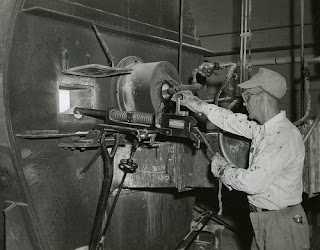Chauchat Machine Gun. Click on image to enlarge.
Due to the Chauchat's unreliability under battlefield conditions, US troops turned to the redoubtable John Browning for help and he delivered the M1918 Browning Automatic Rifle (BAR) design in 1918. This weapon was introduced rather late in the war, but was very effective when it was used during this short time. The first time it was used was September 13th 1918 and one of the people demonstrating its use against the enemy was John Browning's son, Val Allen Browning.
Browning Automatic Rifle. Click on image to enlarge. Public domain image.
The BAR was so successful that the French ordered 15,000 of them to replace their own Chauchats! The BAR remained in production until the 1950s.
Note that both the Chauchat and BAR use full-size rifle cartridges. There were also automatic weapons designed during World War I, that used pistol ammunition. The most famous of these was the Thompson submachine gun, the so called "Tommy gun" that we studied about previously, when we studied the Blish lock mechanism. Both the Tommy gun and the BAR were designed rather late in the war though and the Tommy gun never saw action in World War I, but saw plenty of action in the hands of mobsters.
During the peace time period of World War I, several people argued for a new intermediate cartridge that was smaller than existing rifle cartridges, but bigger than pistol cartridges, and a suitable weapon to fire this new cartridge. The Swiss designer Furrer made an intermediate 7.65x35 cartridge for a carbine in 1921 and one Hauptmann Piderit of the German Rifle Testing Commission also advocated a shorter cartridge and a rifle to fire it. Colonel Fedorov, who we studied in the previous post, was also arguing for a smaller cartridge. There were also experiments made in Denmark and the US.
It was however, Germany, where some of the major new development took place. The Germans had observed that a small group of soldiers could easily overcome a larger group, provided that they had superior firepower. It was also observed that most infantry combat happened at less than 400 meters or so. By the 1930s, at least 5 German companies (Geco, DWM, RWS, Rheinmetall and Polte Patronenfabrik) were experimenting with intermediate rifle cartridges. It was Polte that was officially awarded the contract to design a new intermediate cartridge by the German military and after some experiments, came out with the 7.92x33 mm. "kurz" (German for "short") cartridge in 1938.
Contracts to design a new rifle for this cartridge were sent to both Walther and Haenel GmbH. Haenel's chief designer was Hugo Schmeisser and his design won out over the Walther design and was designated as the Maschinenkarabiner 1942 (after 1942, the year it was adopted) or MKb 42 for short. It underwent some minor design modifications, as requested by the German military. The Haenel design originally used an open bolt mechanism, but after a few trials, it was requested to make a closed bolt design similar to the Walther entry.
As it turned out, Adolf Hitler was strongly opposed to the new intermediate cartridge and demanded that more submachine guns be built instead. However, the German armament office secretly kept working on this new firearm and to avoid raising suspicions, they christened the weapon as MP 43 (MP = Machine Pistol). Hitler later asked for it to be renamed the MP 44, after some official tests in April 1944, unaware that it was not a machine pistol at all. In July 1944, Hitler held a conference with his generals on the Eastern Front and asked them what they needed most. A general who had no idea that the German armament office had disobeyed Hitler's orders, replied, "We want more of those new rifles!" and a thoroughly confused Hitler asked, "What new rifles?" and the cat was out of the bag. Some people thought they would be executed for disobeying Hitler's direct orders, but once Hitler was given a chance to test-fire the new MP 44 for himself, he became very impressed and enthusiastically gave it the name Sturmgewehr, which is German for "Storm (Assault) Rifle" ("Storm" as in storming a castle or assaulting a castle). This is where the term "Assault Rifle" comes from. Because of this new official name, the MP 44 was rechristened the StG 44.
Sturmgewehr 44 (StG 44), the first firearm to be called "Assault Rifle". Click on image to enlarge. Public domain image.
The StG 44 was heavily used in the Eastern Front and found extremely useful by soldiers. It was also very reliable in the extreme cold conditions of the Russian winter. It had a longer range than the Russian submachine guns, but a comparable rate of fire, switchable firing mode from single shot to full automatic mode, pretty decent accuracy and decent controllability even in fully automatic mode.
The StG 44 is now generally accepted as the world's first successful mass produced assault rifle. It was an encounter with one of these that prompted a Russian tank mechanic to invent his own assault rifle, which would later become one of the most famous designs world wide. But that is the subject of another article.

































